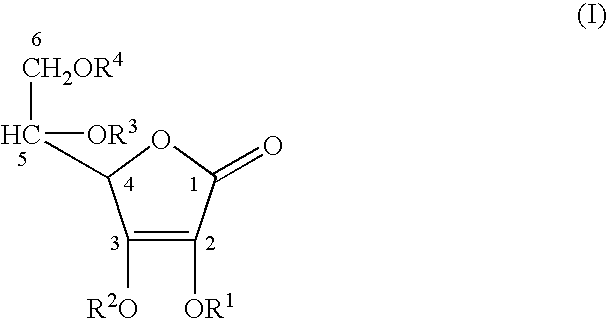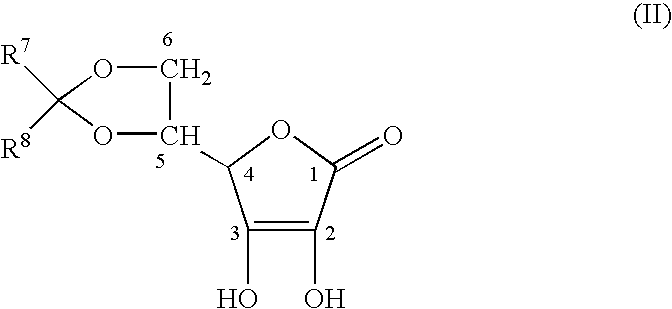Stabilized derivatives of ascorbic aicd
a technology of ascorbic acid and derivatives, which is applied in the direction of biocide, plant growth regulators, food preparation, etc., can solve the problems of bruising and hemorrhaging, gum inflammation, and loosening of is teeth
- Summary
- Abstract
- Description
- Claims
- Application Information
AI Technical Summary
Benefits of technology
Problems solved by technology
Method used
Image
Examples
example 1
Synthesis of Sodium Salt of 2-Capryloyl Ascorbic Acid
Step 1. Synthesis of 5,6-isopropylidenyl ascorbic acid.
[0056] 20 g (0.125 mol) of anhydrous cupric sulfate were added to a suspension of 20 g (0.114 mol) of ascorbic acid in 660 mL of dry acetone. The reaction mixture was stirred for 20 h at room temperature. The process was monitored by TLC (chloroform-methanol-water, 10:10:3). After filtration and evaporation 22.57 g (92%) of 5,6-isopropylidenyl ascorbic acid were obtained.
Step 2. Synthesis of 2-capryloyl-5,6-isopropylidenyl ascorbic acid.
[0057] Capryloyl chloride (12.0 g, 0.074 mol) was added dropwise at 0° C. to a solution of 5,6-isopropylidenyl ascorbic acid (14.5 g, 0.067 mol) in dry pyridine (80 mL). The reaction system was stirred for 1.5 h at 0° C., and the process was monitored by TLC (chloroform-methanol, 3:1). Afterwards, ice water (300 mL) was added and the reaction mixture was adjusted to pH 3 using phosphoric acid (˜10 mL) and extracted with ethyl acetate (2×1...
example 2
Synthesis of Sodium Salt of 2-Palmitoyl Ascorbic Acid
Step 1. Synthesis of 5,6-isopropylidenyl ascorbic acid.
[0060] 20 g (0.125 mol) of anhydrous cupric sulfate were added to a suspension of 20 g (0.114 mol) of ascorbic acid in 660 mL of dry acetone. The reaction mixture was stirred for 20 h at room temperature. The process was monitored by TLC (chloroform-methanol-water, 10:10:3). After filtration and evaporation 22.57 g (92%) of 5,6-isopropylidenyl ascorbic acid were obtained.
Step 2. Synthesis of 2-palmitoyl-5,6-isopropylidenyl ascorbic acid.
[0061] Palmitoyl chloride (12.0 g, 0.074 mol) was added dropwise at 0° C. to a solution of 5,6-isopropylidenyl ascorbic acid (14.5 g, 0.067 mol) in dry pyridine (80 mL). The reaction system was stirred for 1.5 h at 0° C., and the process was monitored by TLC (chloroform-methanol, 3:1). Afterwards, ice water (300 mL) was added and the reaction mixture was adjusted to pH 3 using phosphoric acid (˜10 mL) and extracted with ethyl acetate (2×1...
example 3
Dermatological Effect—Stimulation of Collagen Synthesis in Primary Human Foreskin Fibroblasts by Ascorbic Acid Derivatives
[0065] L-Ascorbic acid stimulates collagen synthesis in cultured human skin fibroblasts. Ascorbate contributes to several metabolic processes including efficient hydroxylation of hydroxyproline in collagen synthesis.
[0066] In order to evaluate the effect of the ascorbic acid derivatives of the invention on collagen synthesis, cultured human foreskin fibroblasts are placed in 24-well microculture plates in DMEM supplemented with 10% fetal calf serum containing 100 μg / ml beta-aminopropionitrile, 10 μCi [2,3-3H]proline, in the presence of either ascorbic acid (positive control) or the ascorbic acid derivative of Example 1 or 2 in different concentrations, e.g. from 1 mM to 50 mM. The cultures are incubated for 24 hours. The [2,3-3H]-proline incorporation into pepsine-resistant salt precipitated extracellular collagen is determined and used as an index of efficienc...
PUM
 Login to View More
Login to View More Abstract
Description
Claims
Application Information
 Login to View More
Login to View More - R&D
- Intellectual Property
- Life Sciences
- Materials
- Tech Scout
- Unparalleled Data Quality
- Higher Quality Content
- 60% Fewer Hallucinations
Browse by: Latest US Patents, China's latest patents, Technical Efficacy Thesaurus, Application Domain, Technology Topic, Popular Technical Reports.
© 2025 PatSnap. All rights reserved.Legal|Privacy policy|Modern Slavery Act Transparency Statement|Sitemap|About US| Contact US: help@patsnap.com



